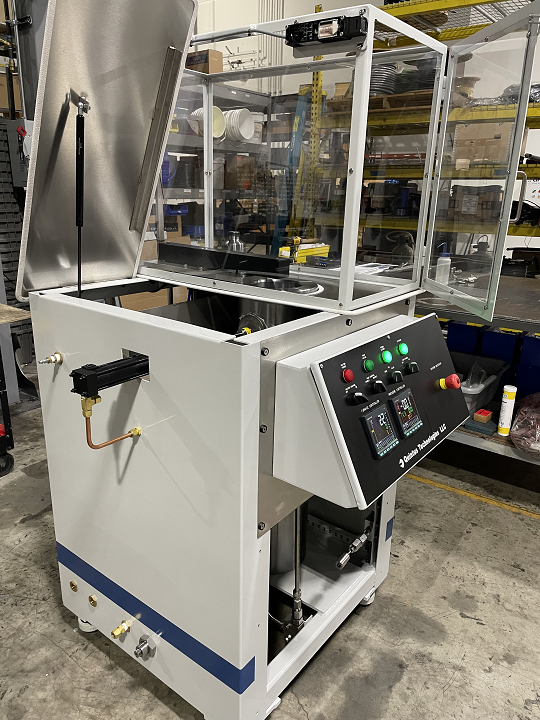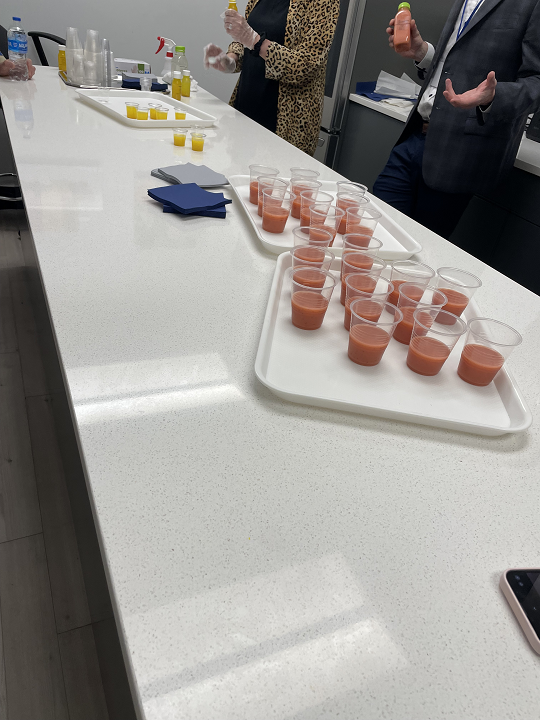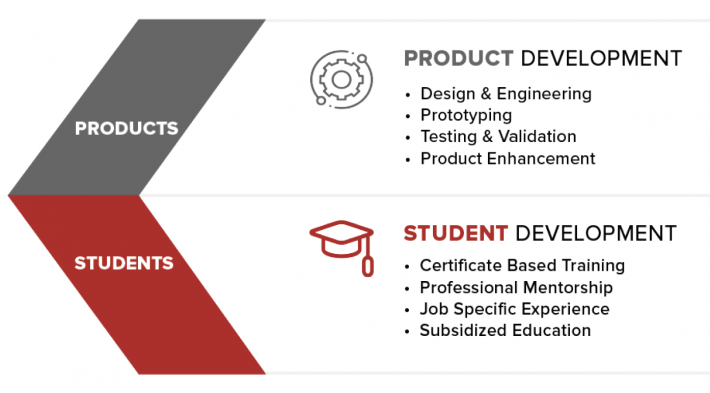I recently attended the biannual ASTM F42/ISO TC 261 meetings at The Ohio State University in nearby Columbus, Ohio. It was one of the most well-organized industry events I’ve ever attended, and it started with a facility tour of Quintus Technologies, which is based in Sweden but has an Application Center in the Columbus area.
Tour of Quintus Technologies Application Center
Quintus is a high pressure technology provider, specializing in sheet metal forming, high pressure processing (HPP) for the food and beverage industries, and densification of advanced materials for increased performance and mechanical properties; this last includes hot isostatic pressing (HIP) technology. HIP is used to eliminate internal porosity in metal castings and forgings, and now metal AM as well. Pores and voids can often form in metal 3D printed parts, which degrade their mechanical properties and make them ill-suited for applications in the medical and aerospace fields. But as I learned at Quintus, HIP helps to improve the overall mechanical properties of the cast, forged, or printed parts by allowing for a higher amount of porosity in as-printed condition. Plus, it can apparently improve print speed as well.
During the facility tour, everyone was efficiently split into four groups and headed off to various parts of the factory floor. In addition to the HIP system, the groups also saw the MIB 120, the company’s small-footprint monoblock isostatic battery press developed for laboratory and research environments; our tour guide explained that the machine can also be “scaled up to anything larger.” As the company explains on its website, isostatic pressing can “increase contact between components in solid-state battery cells,” which results in higher power density and reduced resistivity. The technology is also used to produce the individual components needed to drive development of future battery technologies.
We also got to see the company’s HPP system, and its pressing technology is an antimicrobial process with excellent capabilities for inactivating many concerning food pathogens. Rather than preservatives and high temperatures, the machine uses cold water to extend the refrigerated shelf life of food and beverages, like hummus, baby food, guacamole, smoothies, and packaged, deli, and dry cured meats. The packaged products go into a wire wound vessel, which is then filled with pure water. The water and contents are then pressurized, using specially designed intensifier pumps that reach as high as 87,000 psi. Because the process has no effect on covalent bonds, it doesn’t affect the nutritional components.
While the HPP system for the food and beverage industry doesn’t have anything to do with AM, it was a favorite stop on the tour because they passed out samples of smoothies that had gone through the press!
Tour of Center for Design and Manufacturing Excellence
On the second day of the ASTM/ISO meetings, everyone had the opportunity to tour the College of Engineering’s Center for Design and Manufacturing Excellence, or CDME, which is on a mission to “advance the manufacturing competitiveness of the United States” and “improve national security by developing, demonstrating and deploying advanced manufacturing technologies.” Student employees and technical staff members, who advise and mentor the students, partner with researchers and companies, using modern technologies to create and manufacture market-ready products. This gives the students real hands-on experience, while also offering customers a competitive workforce advantage.
The CDME has four strategic goals:
- Be the standard for other universities in developing and deploying advanced manufacturing
- Provide a sustainable talent pipeline where students have portfolios of relevant work experiences, confidence to make critical decisions, and access to career opportunities
- Maintain close, embedded corporate relationships with industry and government clients
- Double the technical depth of the center’s advanced manufacturing competencies
Over 520 applied engineering projects have been successfully completed by the CDME at its 45,000 square-foot ITAR compliant facility on campus, which is home to over $20 million worth of industrial-scale equipment, most of which we had an opportunity to see on the tour.
Everyone was split into groups, each of which was led by a student employee. They kept us on a tight but necessary timetable, making sure no one got left behind and efficiently guiding us through the building. At each stop, one or two student employees presented a poster about the lab or division’s work, showed us around, and answered questions. Due to the nature of some of the CDME’s ongoing projects, we were not allowed to take pictures inside; as such, the following images, unless otherwise noted, are from the CDME website.
Metal Casting Foundry
The first stop on my group’s tour was the Metal Casting Foundry, which we learned does a lot of work with the aerospace industry. In addition to using die casting and vacuum melting, the foundry—part of the CDME’s Materials & Process (M&P) division—also develops additive process research and creates additive tooling, such as 3D printed molds and patterns. As the student employee told us, they “don’t have to worry about draft angles anymore” thanks to AM, and that the technology also enables them to simulate everything with software first. There were a few large 3D printed sand molds on display, which are used for casting applications. The same student employee said that AM makes mold design more flexible.
Ultrasonic AM & Post-Processing
Next up was an area for post-processing equipment, including two EDM machines and a Solukon SFM-AT800-S depowdering system. An ultrasonic additive manufacturing (UAM) system was also housed in the space, and we learned from the student employee that, thanks to a grant, the CDME was able to partner with Fabrisonic to use one of its SonicLayer UAM printers to make demonstration parts.

L-R: John Middendorf, Director of Additive Manufacturing; Michael Lander, Additive Research Engineer; Ben DiMarco, Additive Principal Engineer, with the Solukon SFM-AT800-S.
Materials Testing Lab
In the Materials Testing Lab, also part of the M&P division, student employees and full-time researchers carry out tensile, fatigue, and hardness testing. We learned about one project in which they improved the performance of waveguides using a copper nickel alloy, and another one that had the team adding carbon nanotubes to aluminum and Inconel alloys for improved strength.
This lab also worked on the BOD2 concrete construction project back in 2023. While that specific printer has since been removed from OSU and installed at a community college in Kentucky for a similar project, we learned from the student employee that the CDME will soon be getting a smaller version of the massive BOD2 to continue this research.
Additive Manufacturing Lab
Obviously, this lab in the AM Division was a major point of interest on the tour. We learned that the lab employs six full-time AM engineers and a number of undergrad students, who take care of everything in the lab except for filter changes and actually pushing “start” on prints.
Over $8 million worth of AM equipment is housed in the lab, capable of processing ceramics, polymers, metals, composites, and even biomaterials. The team uses Addiguru and AMSENSE solutions for AM process monitoring.
I saw machines from:
- Arcam
- Trumpf
- EOS
- FormUp
- AMCM
- GE Additive (now Colibrium Additive)
- Open Additive
Also, all the equipment is often updated, upgraded, and replaced so all undergraduate students have the chance to work with the most advanced manufacturing systems.
Medical Modeling Materials & Manufacturing (M4)
The M4 Division’s lab, which focuses on research innovations in clinical 3D printing, bioengineering, and medical device development, is actually located a mile away, at the Pelotonia Research Center, but they set up their poster session at the main CDME facility to reduce the amount of bus rides we all had to take around campus. The lab employs 17 undergrads and six staff members, and it’s helped with over 200 cases in the past three years.
The M4 Lab creates 3D printed anatomic models, which are used during uncommon or complex surgeries at The Ohio State University Wexner Medical Center. The models can be used for patient education, surgical planning, and even medical training. The team also develops specific simulators for medical training purposes, including a 3D printed ear mold we saw that teaches students how to drain a hematoma, as well as patient-specific prosthetics and orthotics.

M4 Lab leader Dr. Kyle VanKoevering holds a 3D anatomic model of the right pelvis of a patient with a pelvic tumor. The bony pelvis structure is clear, the tumor is yellow, the femoral artery is red and the femoral vein is blue.
In terms of equipment, the M4 division has an Allevi 3 bioprinter, an Artec 3D scanner, a silicone molding system, and several 3D printers, including a Formlabs Form 3B, a Stratasys J5 MediJet, an UltiMaker S5, and more.
AIMS Lab
The study and development of manufacturing systems that work with, and are controlled by, various types of artificial intelligence (AI) takes place in the CDME’s Artificially Intelligent Manufacturing Systems (AIMS) Lab. The staff, student employees, industry partners, and researchers leverage in-house robotic systems, model-based simulations, computational processing, and machine vision capabilities to support next-gen manufacturing. Those who work in the AIMS lab also use electrical assembly, welding, die casting, injection molding, waterjet and laser cutting, and many AM methods, and provide characterization capabilities like optical emission spectrometry and corrosion analysis.
The 1,500-square-foot lab space houses five large Yaskawa robot arms, and many of the lab’s tools and capabilities are published on its Github page, in the name of open source manufacturing. During our stop, we learned a little about several initiatives the AIMS Lab has worked on, including robotic painting, a pick and place project, and an autonomous robotic forging project for the United States Air Force.
Program Management Group
My group’s last stop was the Programs Management Group, which has managed more than 70 projects worth over $30 million. The division is just what it sounds like—the staff and student employees take on the administrative burden of defining and running research projects. They help with everything in contract management, from pre-planning and project agreements, cost management, scheduling, and compliance tracking to personnel management, delivery, closeouts, and post-project feedback and reporting.
“The Program Management Division ensures once a project has been funded, students are actively involved with the management of the project and PMP principles are taught,” the website explains.
“CDME defines project ground rules, creates data management plans, tracks costs and executes a program plan to keep projects on schedule and on budget.”
Program Manager Michael Gentil told us that the division plans to push this completed management program out to all Ohio universities, an initiative I’ll definitely be following closely.
I was extremely impressed by the atmosphere at the CDME, and the work it’s doing. According to a recent Deloitte study, the U.S. needs 3.8 million manufacturing workers by 2033, and that without “significant changes” to our workforce development efforts, more than half of those jobs could be unfilled. If all colleges and universities took a page out of the CDME’s book, I don’t think this will be an issue.
The kids are alright.
Subscribe to Our Email Newsletter
Stay up-to-date on all the latest news from the 3D printing industry and receive information and offers from third party vendors.
You May Also Like
The New BOD 3 Construction 3D Printer from COBOD, Already Deployed across Three Countries
Danish firm COBOD is releasing a new printer, the BOD3 3D Construction Printer. Already in use in Bahrain, Indonesia, and Angola, the track-based machine can print buildings sequentially, row by...
3D Printing News Briefs, October 12, 2024: IPO, Laser Path Optimization, & More
In 3D Printing News Briefs today, WOL3D India recently celebrated its IPO, while BLT signed a distribution agreement with Sicnova and SPEE3D announced a funding partnership with dual-use security investment...
3D Printing Webinar and Event Roundup: October 6, 2024
Things are picking back up in this week’s roundup, with many events, both virtual and in-person! Read on for all the details! 3D Printing News Unpeeled Our Executive Editor Joris...
America Makes Announces New Elected Members of 2024-2026 Executive Committee
Ohio-based America Makes, a public-private partnership for additive manufacturing driven by the National Center for Defense Manufacturing and Machining (NCDMM) non-profit, is the National Additive Manufacturing Innovation Institute (MII). It...













































